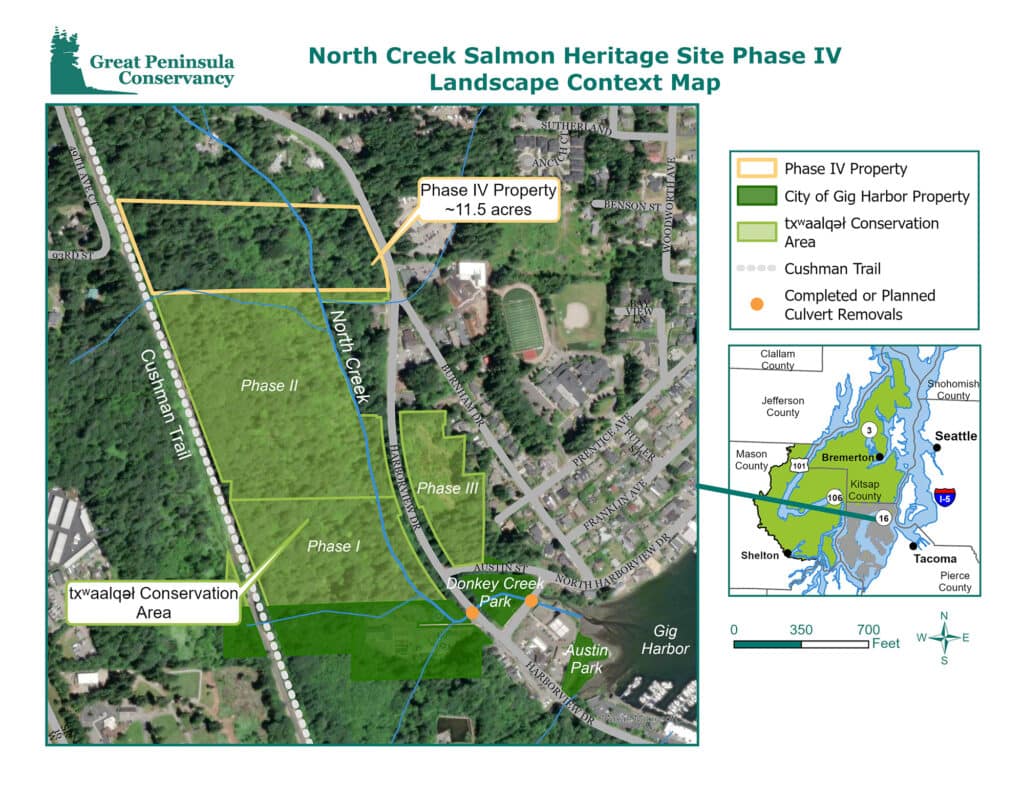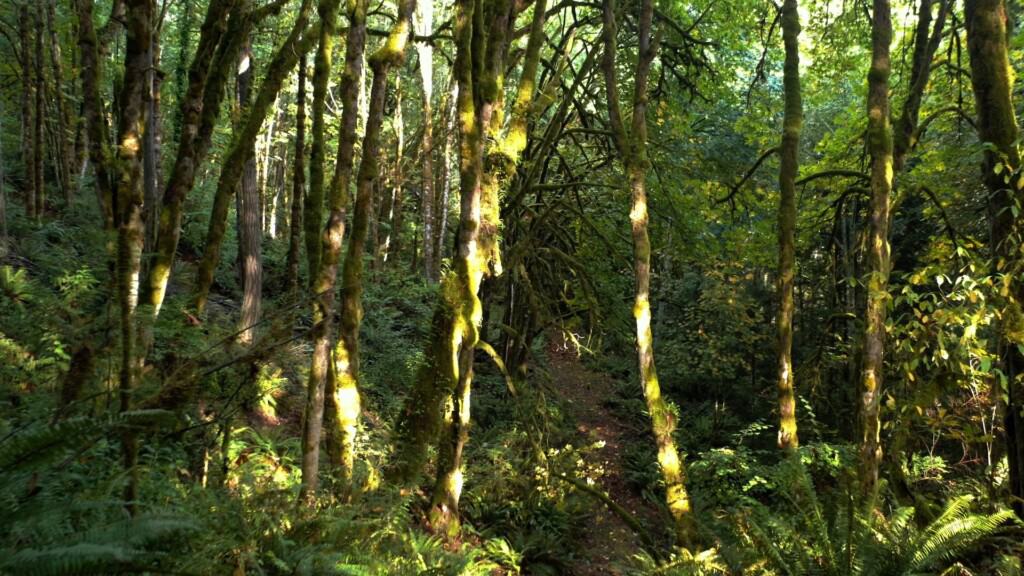Community Environment Government
Phase IV purchase is ‘last piece of the puzzle’ for new conservation area
Since 2022, the city of Gig Harbor has worked to create a conservation area, called the txʷaalqəł Conservation Area, spanning 40.5 acres of land near the heart of downtown.
The city’s recent purchase of property from two private landowners increased those 40.5 acres to just shy of 52 total acres.
The city acquired the land in phases, with this most recent purchase labeled as Phase IV. All of it is protected from development in perpetuity.

The addition of Phase IV brings the txʷaalqəł Conservation Area to nearly 52 acres.
Phase IV purchase
At the end of August, the city closed the purchase of land further encompassing North Creek (also known as Donkey Creek) that provides a fertile and healthy habitat for coho and chum salmon, coastal cutthroat trout and Puget Sound steelhead trout. The National Oceanic and Atmospheric Administration (NOAA) lists the latter as threatened. Tribal partners and private organizations are working with NOAA to help these trout recover.
As with the rest of the conservation area, the thriving wetlands, waters and forest will remain untouched — with a few exceptions for maintained trails, signage and perhaps a parking lot for hikers.
Gig Harbor Parks Manager Jennifer Haro said in an email that the Puyallup Tribe will also use the area to practice traditional gathering. She added that the city hopes to partner with the tribe to create signage with the original Twulshootseed names for native plants, as well as educational signage regarding the historical and cultural significance of the area to the tribe.
“The fact that it is still undeveloped and connected to other undeveloped properties means that there’s an entire corridor now, a mile of the stream, that is now protected for that salmon habitat. Especially in the heart of downtown, it is an incredibly rare thing to have,” said Ali Querin, the conservation project manager for the Great Peninsula Conservancy (GPC).
Willing sellers
Querin was heavily involved in acquiring the land for the conservation area, including negotiating with property owners Carolyn and Walter Brooks and writing grants. Fortunately, she said, neither of the Brooks needed much persuading.
“They’d actually had plans for the property that didn’t come through and they’d been holding it,” Querin explained. “They agreed that this was a great use and they’d love to see it become part of the community green space. They thought that would be an excellent way for the property to end up.”
The city bought the property for $675,000, Querin said, the majority of which came from the Pierce County Conservation Futures Program. Other backers included the Gig Harbor & Key Peninsula Land Fund (which recently joined GPC), The Russell Family Foundation, The Hugh and Jane Ferguson Foundation, Gig Harbor Rotary and the KGI Watershed Council.
Next steps
Now, the city’s next task is to create a management plan, in the same way it did for the first two pieces of land it purchased for the conservation property, Haro said. This will have to happen within a year, she said.
The property won’t open for recreation immediately. Haro said the city plans to inspect an existing bridge on Phase II of the conservation area to see if it can provide safe public access to the conservation site. Then the city hopes to open an existing overgrown trail. She estimated that could happen next summer, if all goes well. The city plans to find locations for trails in the other pieces of land next year.

Phase IV is 11.5 acres fronting Donkey Creek and adjacent to previously purchased and conserved land. Photo courtesy of city of Gig Harbor
The city is also in the process of requesting funding for design and permitting of the Harborview-Cushman Connector Trail in next year’s budget to allow for a longer and more formal trail to link the existing Cushman Trail to Harborview Drive, close to the wastewater treatment plant. She said the city hopes to complete the trail system by 2026.
Environmental benefits
Dr. Michael Behrens fundraised for the conservation area on behalf of the Gig Harbor & Key Peninsula Land Fund Committee, and recently joined the GPC’s board of directors. He said in an email that working to protect the land in this way is particularly important for a variety of reasons.
In addition to supporting multiple fish species and preserving “a beautiful forested habitat” for all sorts of flora and fauna, “intact forests and stream ecosystems can be important filters that maintain water quality as it enters Gig Harbor.”
“The environmental impacts of not preserving land such as this will lead to continued fragmentation of forests, which can dramatically impact the diversity of the systems and the size of plant and wildlife populations that they can support,” said Behrens, a biology professor at Pacific Lutheran University in Tacoma. “Additionally, clearing of forests near streams can increase runoff of sediment and disrupt natural nutrient flow into the streams, which can negatively impact many native species. Clearing of streamside vegetation can also warm the stream making them inhospitable to many fish and insect species.”
A team effort
Behrens also feels it’s “quite remarkable” that so many groups came together to protect such a large amount of contiguous green space in a growing city.
“Phase IV is the last piece of the puzzle when it comes to the txʷaalqəł Conservation Area. All the land upstream of Phase IV has been developed,” Behrens said. “The city has invested significant resources in the health of this watershed from the ‘daylighting’ of the creek at Donkey Creek Park to the preservation of over 50 acres of forested habitats. This is a big win for the human and non-human residents of Gig Harbor.”
Haro agreed that the conservation of the area “is great news for the animals, plants and humans.”
“The second-growth trees on the site are already mature and diverse, unlike some of our other properties that were planted with only Douglas fir for future harvesting,” Haro said. “The forest will be allowed to age naturally, and animals will have a safe haven from development around it. Humans will also have cleaner air and a large green patch to enjoy as they travel up and down Harborview and Burnham Drive.”
While the city is not planning to expand the conservation area, Haro said that they are open to partnership opportunities or land donations, if any become available. Both she and the city on its webpage also gave a particular shoutout to Querin, whom Haro said “did the heavy lifting on this acquisition,” and to current District 7 Pierce County Councilmember Robyn Denson, who came up with the idea to work with GPC, and worked in her role at the Gig Harbor & Key Peninsula Land Fund to fundraise for the matching funds.
